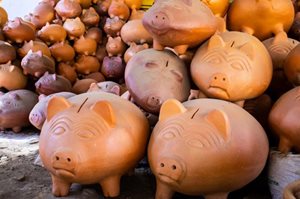Your first exposure to building your savings might have been through adding coins to a piggy bank. But have you ever stopped to wonder why people started putting money into piggy banks? To answer this question, we will highlight the history of piggy banks and why the pig came to be considered a symbol for saving money.
Origins of the Piggy Bank
 The invention of the piggy bank originates to over 600 years ago in the 15th century in a time before real banks even existed. Before the creation of modern-style banking institutions, people commonly stored their money at home in pots. During The Middle Ages, metal was expensive and rarely used for household wares. Instead, dishes and pots were made of an inexpensive, orange-colored clay called pygg. Whenever people had a couple extra coins, they would drop it into their clay jars which they referred to as ‘pygg’ pots or, a ‘pygg’ bank.
The invention of the piggy bank originates to over 600 years ago in the 15th century in a time before real banks even existed. Before the creation of modern-style banking institutions, people commonly stored their money at home in pots. During The Middle Ages, metal was expensive and rarely used for household wares. Instead, dishes and pots were made of an inexpensive, orange-colored clay called pygg. Whenever people had a couple extra coins, they would drop it into their clay jars which they referred to as ‘pygg’ pots or, a ‘pygg’ bank.
Vowels in early English had different sounds than they do today. So during the time of the Saxons the word pygg would have been pronounced “pug.” But as the pronunciation of “y” changed from a “u” to an “i,” pygg eventually came to be pronounced “pig.”
Perhaps coincidentally, the Old English word for pigs (the farm animal) was “picga,” with the Middle English word evolving into “pigge,” possibly because the animals rolled around in pygg mud and dirt.
 Over the next few hundred years, as the English language evolved, the clay pygg and the animal pigge came to be pronounced the same. English potters began shaping ‘pygg’ pots into the shape of pigs as a play on words. This soon became a trend, and people would request their ‘pygg’ pots to be shaped like pigs. Europeans slowly forgot that pygg once referred to the earthenware pots of yesteryear and it became the norm by the 19th century, for English potters to create pots shaped like pigs for people to use as a bank.
Over the next few hundred years, as the English language evolved, the clay pygg and the animal pigge came to be pronounced the same. English potters began shaping ‘pygg’ pots into the shape of pigs as a play on words. This soon became a trend, and people would request their ‘pygg’ pots to be shaped like pigs. Europeans slowly forgot that pygg once referred to the earthenware pots of yesteryear and it became the norm by the 19th century, for English potters to create pots shaped like pigs for people to use as a bank.
Modern Piggy Banks
In some European countries, such as Germany and the Netherlands, the pig represents luck and good fortune. So it’s customary to gift people with a piggy bank as a symbol of prosperity. Piggy banks arrived and became popular in the U.S. during the 19th century, when there was an influx of Germans entering the U.S. who had been using money boxes in the shape of pigs for centuries.
 Today piggy banks have become an enduring icon for financial literacy and a tool to teach kids about the importance of saving money. The practical purpose of the piggy bank has stood the test of time, to encourage people to save money. With the rise of digital banking and cashless transactions, the act of physically putting money into a piggy bank may seem a little outdated. However, the fundamental principle of saving remains as important as ever. So, let us not forget the humble piggy bank, may it remind us of the importance of healthy savings habits.
Today piggy banks have become an enduring icon for financial literacy and a tool to teach kids about the importance of saving money. The practical purpose of the piggy bank has stood the test of time, to encourage people to save money. With the rise of digital banking and cashless transactions, the act of physically putting money into a piggy bank may seem a little outdated. However, the fundamental principle of saving remains as important as ever. So, let us not forget the humble piggy bank, may it remind us of the importance of healthy savings habits.